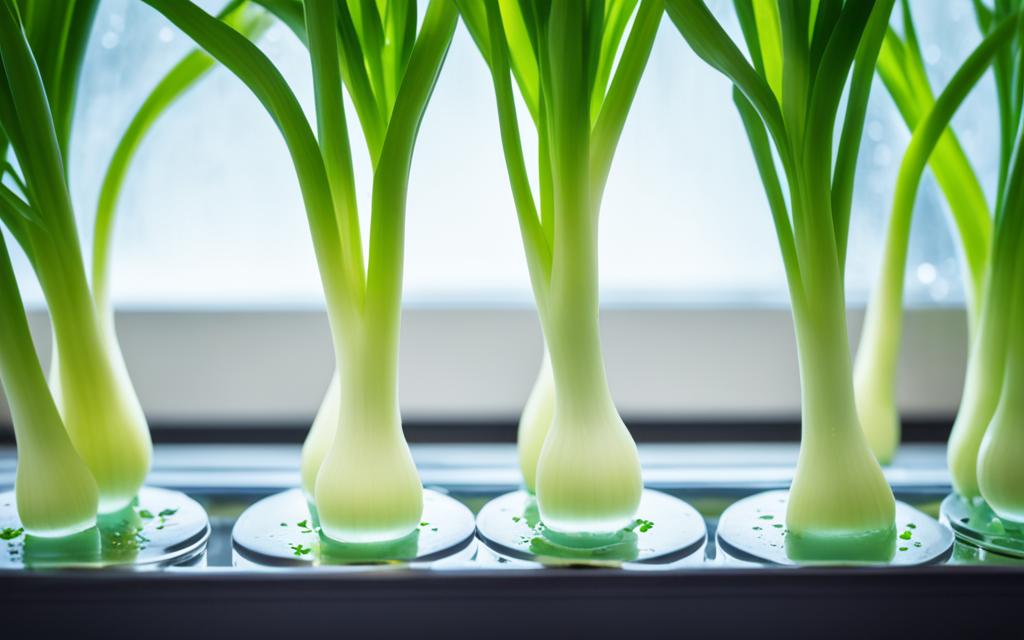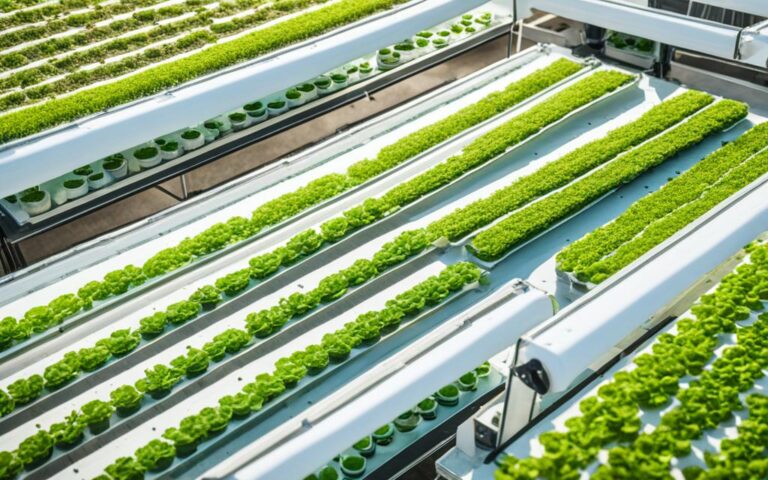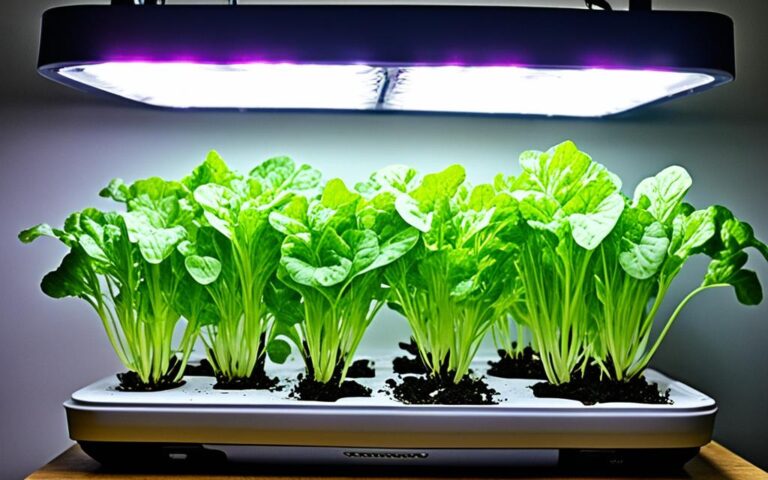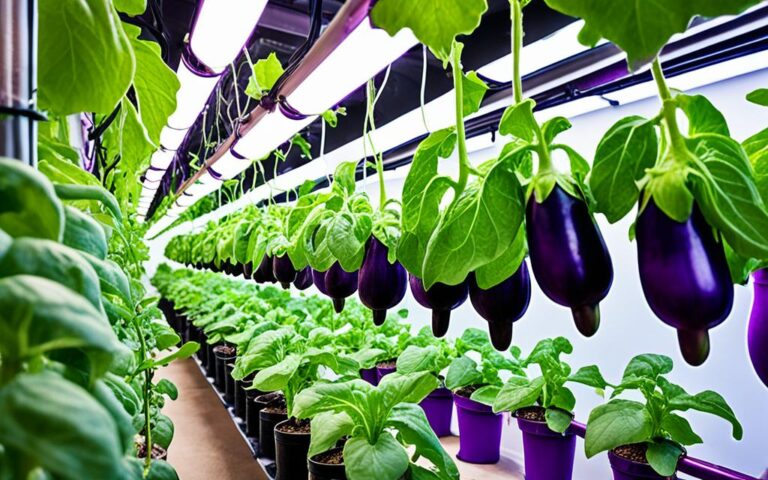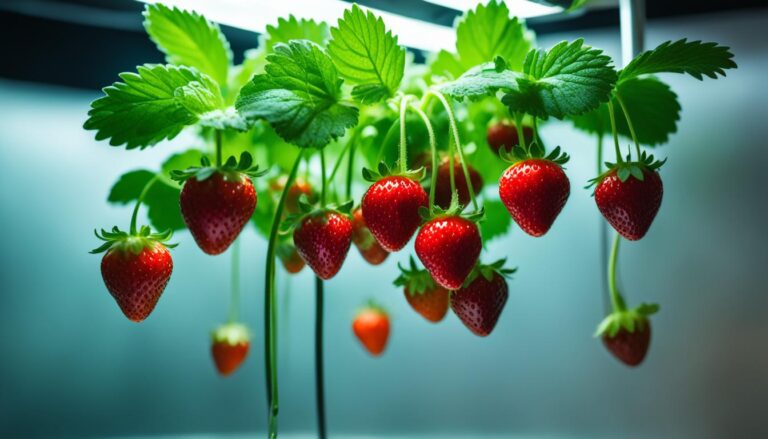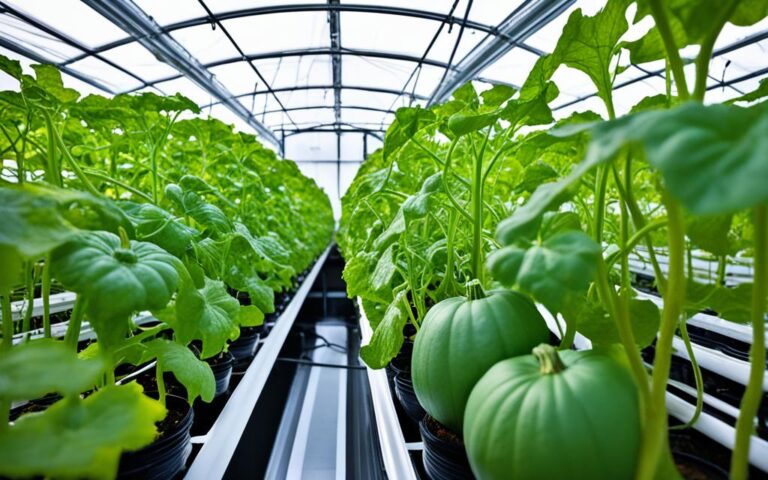Growing Hydroponic Green Onions: Home Guide
Green onions, also called scallions or spring onions, are key in many dishes. They add a fresh flavor. Growing them hydroponically is a great way to get a lot of food without much space. This method is soil-free, efficient, and lets you grow food all year.
This guide will show you how to grow green onions hydroponically. You’ll learn everything you need to know to start growing your own.
Key Takeaways
- Hydroponic green onions can be grown year-round, even in limited spaces, providing a consistent supply of fresh produce.
- Hydroponic systems allow for precise control over the growing environment, leading to faster growth and higher yields compared to traditional soil-based methods.
- Proper nutrient management, including pH and electrical conductivity (EC) levels, is crucial for healthy hydroponic green onion plants.
- Consistent monitoring and maintenance of the hydroponic system are essential for the optimal growth and development of green onions.
- Selecting the right hydroponic system and green onion variety can maximize the overall productivity and quality of the harvest.
Table of Contents
Starting Green Onions Hydroponically
Growing hydroponic green onions can be done in two ways: from seeds or cuttings. Each method has its own benefits and things to consider.
Starting From Seed
Starting with hydroponic green onions seeds lets gardeners see the plant grow from start to finish. It teaches about picking the right seeds, helping them sprout, moving them, and feeding them.
Green onion seeds start growing in 4-5 days under the best conditions. They can grow to maturity in 60-90 days with the right care. Choosing the right seeds and keeping an eye on things like pH levels, temperature, and plant spacing is key for growing hydroponic green onions from seeds.
Starting From Cutting
Using cuttings is a great way to grow hydroponic green onions at home or for eco-friendly gardening. It uses parts of the onion that would otherwise go to waste. To start, you need to pick the right cuttings, prepare them, help them develop roots, and then move them to a new spot.
Starting hydroponic green onions from cuttings is quicker and more efficient than from seeds. With the right care, you can quickly grow a lot of hydroponic bunching onions or hydroponic spring onions.
No matter which method you pick, growing hydroponic green onions needs careful attention and knowledge of what they need to thrive. Learning how to grow them from seeds or cuttings will help you have a great harvest of hydroponic scallions.
Growing Green Onions in Different Hydroponic Systems
Media Bed Method
The Media Bed, also known as the Flood and Drain or Ebb and Flow system, is a top choice for hydroponic green onions. It uses a growing media like expanded clay pellets or coconut coir. This media supports the plants and holds water. To grow green onions in a Media Bed system, you need to set it up easily, use the right media, and check the nutrient solution’s pH and EC often for best growth.
In this system, the growing media sits in a tray or container. Nutrient solution flows in, then drains back out, creating a cycle. This “ebb and flow” helps roots get water and air, making hydroponic bunching onions grow well.
This method is easy to start and keeps the roots healthy. The regular flow of solution prevents salt and mineral buildup, unlike some other systems.
For green onions hydroponic ebb and flow to work well, check the nutrient solution’s pH and EC often. Keep the pH between 5.5 and 6.5 and the EC between 1.8 and 2.4 mS/cm. This creates the perfect environment for hydroponic green onions.

“Hydroponically grown green onions can be harvested in 3-4 weeks, significantly faster than traditional soil-based methods.”
The Media Bed method is great for growing hydroponic green onions at home or in small businesses. It’s easy to set up, uses good growing media, and makes managing nutrients simple. This system helps growers get a steady supply of fresh, tasty green onions.
Nutrient Film Technique (NFT) System
The Nutrient Film Technique (NFT) is a top choice for growing hydroponic green onions nft. It uses a thin film of nutrients that flows over the roots of green onions hydroponics nft. This system is designed with a sloped tray or channel. It ensures the roots get enough oxygen and nutrients for quick growth of hydroponic bunching onions nft.
Keeping an eye on pH and EC levels is key in an NFT setup. Green onions hydroponics nft need a steady nutrient flow. So, having a backup power source is a must to avoid any disruptions.
| NFT System Specifications | Recommended Values |
|---|---|
| Slope Ratio | 1:30 to 1:40 (1-inch drop per 30 to 40 inches of length) |
| Flow Rate | 1/4 to 1/2 gallon (1 to 2 liters) per minute per channel, or 15 to 30 gallons per hour (60 to 120 liters) |
| Channel Diameter | Approximately 4 inches |
| Net Cup Size | 2 inches or 3 inches |
| Water Depth | Just a millimeter or two |
The NFT system is great for hydroponic green onions nft because it’s efficient with water and keeps roots oxygenated. It makes sure the green onions hydroponics nft get the nutrients and oxygen they need. This leads to quick and healthy growth.
Hydroponic bunching onions nft in NFT systems need regular checks and a reliable power source. With proper setup and care, the Nutrient Film Technique is a great way to grow hydroponic green onions nft at home.
Deep Water Culture
Deep Water Culture (DWC) is a top choice for growing hydroponic green onions. It suspends the onions in a solution full of nutrients, with their roots in the water. This setup gives the onions constant water, nutrients, and oxygen, helping them grow well.
The DWC system boosts yield a lot. In good weather, it can almost triple the annual harvest compared to old ways. This is because it controls plant growth and quality better, and offers the best growing conditions.
This method also makes the onions taste better and be more nutritious. It uses less water and soil and cuts down on harmful chemicals. This makes it a green and smart way to grow, loved by city farmers, big growers, and backyard gardeners.
But, keeping a DWC system running well needs a lot of work. You must make sure there’s enough air, keep the pH and nutrient levels right. Good air flow stops root rot, and keeping the solution’s pH and EC balanced helps plants grow strong.
| Metric | Traditional Farming | Hydroponic DWC |
|---|---|---|
| Annual Yield | Standard | Almost 3x Higher |
| Water Usage | Higher | Lower |
| Soil Usage | Higher | Lower |
| Pesticide Reliance | Higher | Lower |
| Sustainability | Lower | Higher |
Using DWC hydroponics means more and better hydroponic green onions with less water and resources. It’s a great choice for those wanting a big harvest and a greener way to grow bunching onions.
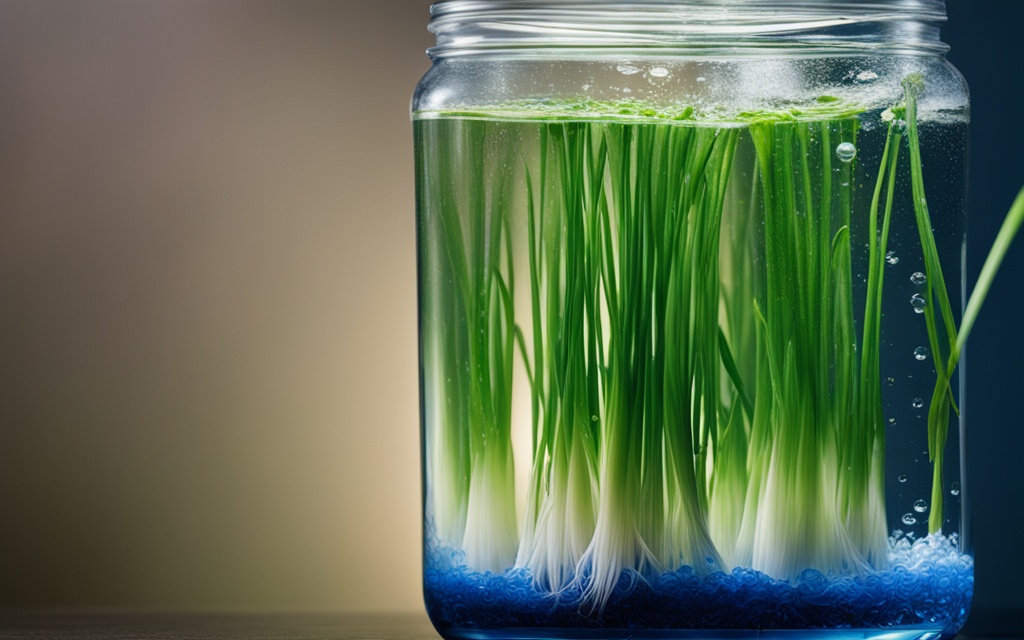
Necessary Conditions for Growing Hydroponic Green Onions
Indoor Growing Space
To grow hydroponic green onions indoors, you need a space with the right temperature and humidity. It must have a steady supply of water, nutrients, and oxygen. Also, good aeration is key to stop root rot. Keeping the temperature between 60°F and 75°F is important for green onions to grow well.
Hydroponic Grow Media & Nutrients
Choosing the right hydroponic grow media and nutrients is key for green onions. Use a medium like perlite, vermiculite, or coconut coir for support and air. A balanced hydroponic nutrient solution with nitrogen, phosphorus, potassium, and more supports growth. Keeping the pH levels between 5.8 and 6.3 and EC levels around 1.2-2.0 mS/cm helps the green onions absorb nutrients well.
With the right indoor setup and nutrients, you can grow a great indoor hydroponic green onion garden or hydroponic green onion tower at home.
“The key to successful hydroponic green onion cultivation is providing the right growing conditions and nutrient balance, which can be achieved through careful monitoring and adjustments.”
Maintaining the Hydroponic Environment & System
To keep your hydroponic green onions healthy, you need to maintain a balanced environment and a working hydroponic system. This means checking and adjusting things like pH levels, electrical conductivity (EC), aeration, temperature, and cleanliness often.
It’s important to check the nutrient solution’s pH and EC levels regularly. The pH should be between 6.5 and 7.0 for good nutrient uptake. Adjust the EC levels based on your green onions’ growth stage. This helps avoid nutrient problems that can slow plant growth.
Good aeration for the roots is key. Use an airstone or a water pump to keep the nutrient solution moving. This ensures the roots get enough oxygen. Keeping the temperature steady between 65°F and 75°F (18°C and 24°C) also helps your onions grow well.
Cleaning your hydroponic gear and system often is a must. This stops algae, bacteria, and other bad stuff from harming your onions. Clean the system and change the nutrient solution when needed to keep things healthy.
Watch for signs of nutrient issues, pests, or diseases. Catching and fixing problems early stops them from getting worse. This keeps your hydroponic green onions safe and healthy.
By keeping an eye on the hydroponic environment and system, you help your green onions stay healthy and productive. This means better growth and more onions for you.
“Hydroponic onions do best with the right balance of nutrients, oxygen, and conditions. Regular checks and adjustments lead to a great hydroponic green onion harvest.”
Harvesting Hydroponic Green Onions
Hydroponic green onions can give you a lot of food if you grow them right. Knowing when and how to pick them is key. This helps the onions keep growing. Let’s look at the best times and ways to harvest hydroponic green onions.
When to Harvest Hydroponic Green Onions
Green onions are ready to pick when they are about 6 inches tall. This happens in 4-6 weeks, depending on the growing conditions and type of onion. The best time to pick them is in the morning, when they are full of water and taste the best.
How to Harvest Hydroponic Green Onions
- Use clean, sharp scissors or shears to cut the green onions just above the root line, leaving about an inch of the white stem and roots intact.
- Gently rinse the harvested green onions under cold water to remove any debris or dirt.
- Pat the green onions dry with a clean paper towel or cloth before storing or using them.
By leaving a small part of the white stem and roots, you help the green onions grow back. This way, you get more harvests from one planting. It’s a great way to use your space well.
Harvesting Tips
- Avoid cutting the green onions too close to the root, as this can damage the plant and inhibit regrowth.
- Harvest only the larger, mature green onions, leaving the smaller ones to continue growing.
- Regularly trim the tops of the green onions, even if you’re not harvesting the entire plant, to encourage bushier growth.
With the right timing and methods, you can have a steady supply of fresh hydroponic green onions. Follow these tips for a bountiful harvest that adds flavor and nutrition to your meals.
| Harvesting Metric | Details |
|---|---|
| Optimal Harvest Height | 6 inches |
| Typical Harvest Timeframe | 4-6 weeks after planting |
| Harvest Time of Day | Morning |
| Harvest Method | Cut above root line, leaving 1 inch of stem and roots |
| Post-Harvest Cleaning | Rinse under cold water, pat dry |
| Regrowth Potential | Multiple harvests possible from the same plant |
Storing Green Onions
Storing hydroponic green onions right is key to keeping them fresh and tasty. Here are easy tips for the best way to store hydroponic green onions.
After picking, make sure to give hydroponic green onions good air flow to stop root rot. Keep them in a cool spot with lots of humidity, like 32°F (0°C). Wrap the green onions in a damp paper towel and put them in a bag that breathes before chilling.
This way, they stay moist but get enough air. Don’t wash the green onions before storing to avoid mold. Make sure they’re dry before you put them away.
Check the green onions often and throw away any that are wilted or damaged. This keeps the rest fresh for up to 10 days. With the right storage of hydroponic green onions, you’ll enjoy their crispness and flavor.

Another way to store hydroponic green onions is to put the white parts with roots in a jar with water. Cover the jar with a plastic bag and change the water every few days to keep the green onions fresh.
For keeping hydroponic green onions longer, you can freeze them. Wash and chop the green onions first. Spread them on a baking sheet and freeze them. Then, move them to a freezer bag or container for up to 6 months.
Selecting the Right Hydroponic Green Onions Variety
Choosing the right hydroponic green onion variety is key to a successful harvest. You should think about growth rate, flavor, and how well they fight pests or diseases. These factors greatly affect your harvest’s success and quality.
Some top hydroponic green onion varieties include:
- Evergreen Bunching: This variety grows fast and produces consistently. It has a mild, sweet taste.
- White Lisbon: It’s a favorite for its compact size and crisp, white stems.
- Apache: Known for its strong flavor and vibrant green color. It also tolerates cold well.
It’s crucial to pick the right hydroponic green onion varieties for your system’s conditions. Some do better in Nutrient Film Technique (NFT) systems, while others in Deep Water Culture (DWC) setups. Make sure to research the best varieties for your hydroponic method for a successful harvest.
| Variety | Growth Rate | Flavor | Pest/Disease Resistance |
|---|---|---|---|
| Evergreen Bunching | Fast | Mild, Sweet | Good |
| White Lisbon | Moderate | Crisp, White | Average |
| Apache | Moderate | Bold | Excellent |
By picking the right hydroponic green onion varieties, you can have a plentiful and tasty harvest. The right choices help you get the most out of your hydroponic green onion growing.
Nutrient Management for hydroponic Green Onions
pH Levels
Keeping the right pH levels is key for hydroponic green onions to grow well. The ideal pH range for green onions is between 5.8 and 6.3. This range helps the plants take in nutrients well and grow healthy.
Electrical Conductivity (EC)
Checking the electrical conductivity (EC) of the nutrient solution is also vital. The recommended EC range for green onions is around 1.2-2.0 mS/cm. This range makes sure the plants get the right nutrients for growth.
Research shows that hydroponic green onions grow better with nutrient solution strengths between 50% and 100%. But, using a 125% solution can make the plants produce fewer leaves and less leaf weight.
Studies also found no big differences in growth when plants were placed at different spots on the hydroponic channels. This means the best growth happens with a nutrient solution of 68.8%, leading to bigger plants and earlier harvests.
Earlier studies showed that mean dry matter production of 5.2 g plant-1 and 16.1 g plant-1 is possible with the right nutrient solutions for green onions. Yet, how plants absorb nutrients can change and affect productivity in hydroponic systems.
To get the best growth from hydroponic green onions, keep the pH and EC levels right. Also, watch the nutrient solution’s strength and mix closely. By doing this, growers can get the most out of their hydroponic green onion crop.
Common Pests and Diseases in Hydroponic Green Onions
Keeping your hydroponic green onions healthy and productive means watching for pests and diseases. You might see aphids, thrips, and fungal diseases like downy mildew. Quick action with pest management and good growing conditions can stop and fix these issues.
Pests Affecting Hydroponic Green Onions
- Spider Mites are tiny and feed on plant cells, making leaves turn yellow and dry.
- Thrips are small and suck the life out of leaves, leaving them brown and dry.
- Aphids come in green, black, or gray and weaken plants by draining their juice, turning leaves yellow.
- Whiteflies are tiny and leave white spots and yellowing on plants.
- Fungus Gnats‘ larvae eat roots, slowing growth and can kill plants.
Some pests have become resistant to control methods in various places. It’s important to keep an eye out and adjust how you manage them.
Diseases in Hydroponic Green Onions
- Powdery Mildew makes plants grow slow, drop leaves, and turn yellow if not treated.
- Downy Mildew shows up on leaf undersides and can make leaves yellow.
- Gray Mold causes fuzzy gray spots on plants and can harm them.
- Root Rot comes from too much water and bad stuff in the medium, making roots mushy.
- Iron Deficiency turns leaves bright yellow but keeps the green veins.
Keeping your indoor garden clean and taking steps to prevent pests and diseases helps a lot. Using the right nutrients, supplements, and sterilizing can make your hydroponic green onions healthier and stronger.
“Addressing pest and disease challenges promptly is crucial for maintaining a thriving hydroponic green onion crop.”
Maximizing Yield of Hydroponic Green Onions
To get the most from hydroponic green onions, you need a detailed plan. This plan includes the right growing conditions, enough nutrients and light, and smart harvesting. By doing this, you can get lots of fresh, tasty green onions.
Optimizing Growing Conditions
It’s key to keep your hydroponic system in top shape for great green onion yields. Check and adjust the pH levels and electrical conductivity (EC) of the nutrient solution often. This helps plants get the nutrients they need. Also, keep the temperature and humidity levels right to help plants grow well and avoid problems.
Providing Adequate Nutrients
Green onions need a lot of nutrients to grow big and strong. They need the right mix of macronutrients (nitrogen, phosphorus, and potassium) and micronutrients (like iron, calcium, and magnesium). Keep an eye on the total dissolved solids (TDS) in the solution to make sure it’s just right for your plants.
Optimizing Lighting
Good lighting is crucial for green onions to grow well. LED grow lights are a great choice because they use less energy and can be set to the perfect spectrum for green onions. These lights work better than old-style lights and don’t get too hot, which is good for your plants.
Efficient Harvesting Techniques
Start harvesting hydroponic green onions in 3-4 weeks after planting. This lets you get more harvests from one crop. Cut the green stems carefully, leaving the base to encourage more growth. Handling and storing the onions right also keeps them fresh and tasty.
By focusing on growing conditions, nutrients, lighting, and harvesting, you can make sure your hydroponic green onions grow well. This way, you’ll have plenty of this tasty vegetable to enjoy.
| Hydroponic System | Suitable Crops | Yield Potential |
|---|---|---|
| Nutrient Film Technique (NFT) | Leafy greens, herbs | High |
| Deep Water Culture (DWC) | Basil, cucumbers | Moderate to High |
| Flood and Drain (Ebb and Flow) | Strawberries, bell peppers | Moderate to High |
“Hydroponic green onions can be harvested in just 3 to 4 weeks following planting, making them a quick-growing option for hydroponic gardens.”
Lighting Requirements for Hydroponic Green Onions
Proper lighting is key for growing hydroponic green onions. These plants do well with the right amount of light. This can come from natural sunlight or grow lights.
For the best growth, hydroponic green onions need 8-10 hours of light daily. At least 5 hours is a must, but more light means better growth. It’s important to give your hydroponic green onions enough light for healthy growth and a good yield.
LED grow lights are great for growing hydroponic green onions. They’re energy-saving and give the right light spectrum. You can also use fluorescent or HID grow lights.
By watching and keeping the right hydroponic green onion lighting, your plants will do great. Whether using natural light, grow lights, or both, knowing the light requirements for hydroponic green onions is key to success.
“Adequate lighting is essential for the healthy growth and development of hydroponic green onions. Providing the right amount of light, whether natural or artificial, will ensure your plants reach their full potential.”
Conclusion
Hydroponic green onion gardening is a great way to grow onions all year. It lets you have fresh, tasty scallions right at home. You just need to know about different hydroponic systems, keep the right conditions, and manage nutrients and pests well.
This method is great for saving space, producing a lot, and using fewer pesticides and herbicides. It’s perfect for both new and experienced gardeners.
Growing hydroponic green onions at home means you can have nutrient-rich produce all year. With the right knowledge and methods, you can make a hydroponic system that gives you lots of fresh, tasty green onions. These systems are easy to maintain and produce a lot, making them a great choice for hydroponic green onion gardening.
The benefits of hydroponic green onion cultivation are huge, and this article will help you start growing hydroponic green onions at home. Try this innovative farming method and enjoy a successful, self-sufficient green onion garden.
